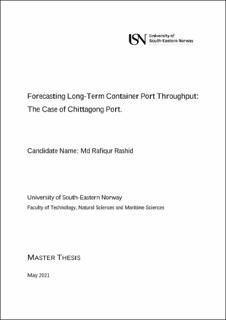| dc.description.abstract | Objective: This study presents a long-term container throughput forecasting approach in the context of Chittagong Port Authority (CPA) for their future development of the container terminal.
Methodology: Time series data of 30 years (51 observations) from 1991-2019 is used. Data is taken from the different yearbooks of CPA, and World Bank Records for Bangladesh. Multivariate autoregressive modelling has been implemented to forecast future container throughout by applying the Vector Error Correction Model (VECM). To find out stationarity and the number of cointegration equations between variables, the Augmented Dickey-Fuller (ADF), and Johansen approach have been applied, respectively. Besides, to check the response to a shock of one variable to others, Impulse Response Function (IRF) is performed. Finally, three statistical techniques are applied to test the accuracy of the model.
Result: The result of the model predicts that container throughput may increase from 2.95 (million TEU) in 2020 to 8.73 (million TEU) in 2040 with the possibility of an average growth rate of 8.9% yearly over the two decades. GDP, Population, and Import are the most important factors and have an influence on the container throughput at CPA will be benefited in port operation and management.
Originality: While majority of the existing studies have forecasted short-term container throughput, this study focuses on long-term forecasting of container throughput. Whilst doing so, the major drivers of container throughout are identified. Further, implications of the long-term forecast for port development are discussed.
Research limitations: This study forecasts container throughput on using port level data. Use of terminal level data could be more useful as port development decision are often made on terminal level now-a-days. Further, a longer time series data for model estimation might improve robustness of the results, which was not possible to implement due to lack of data.
Keywords: Forecasting, Container throughput, Multivariate autoregressive, VECM. | |
